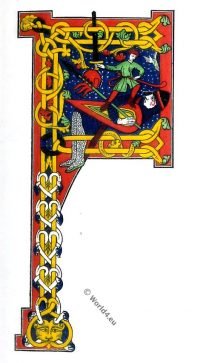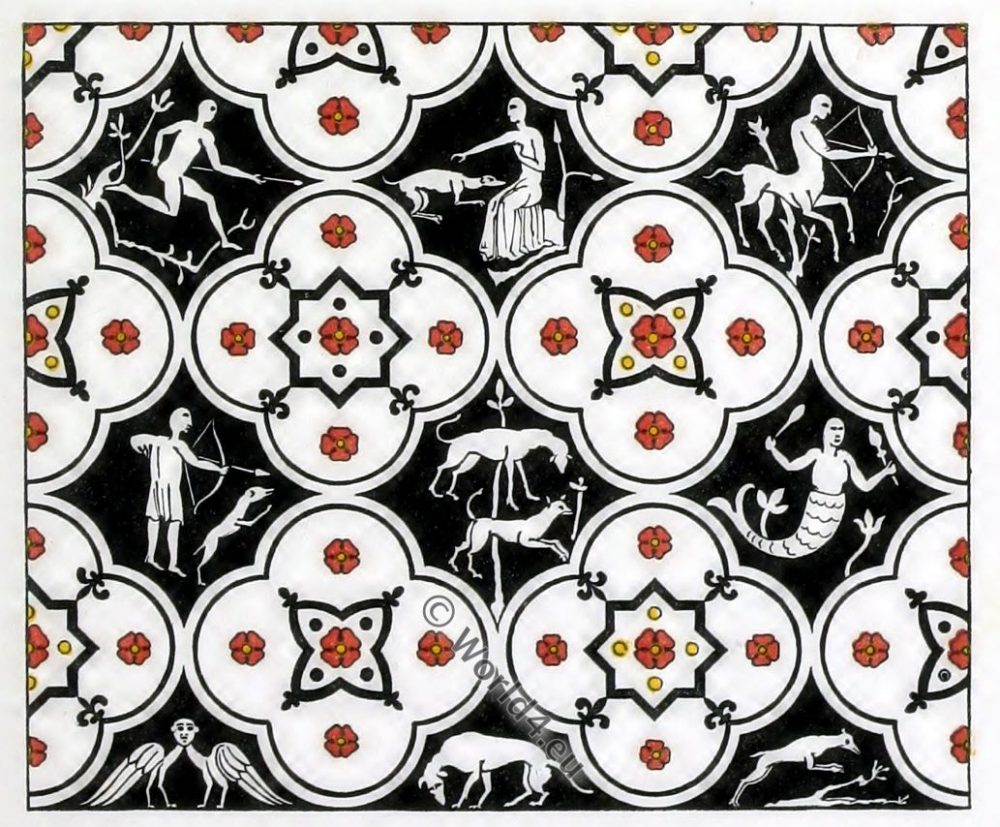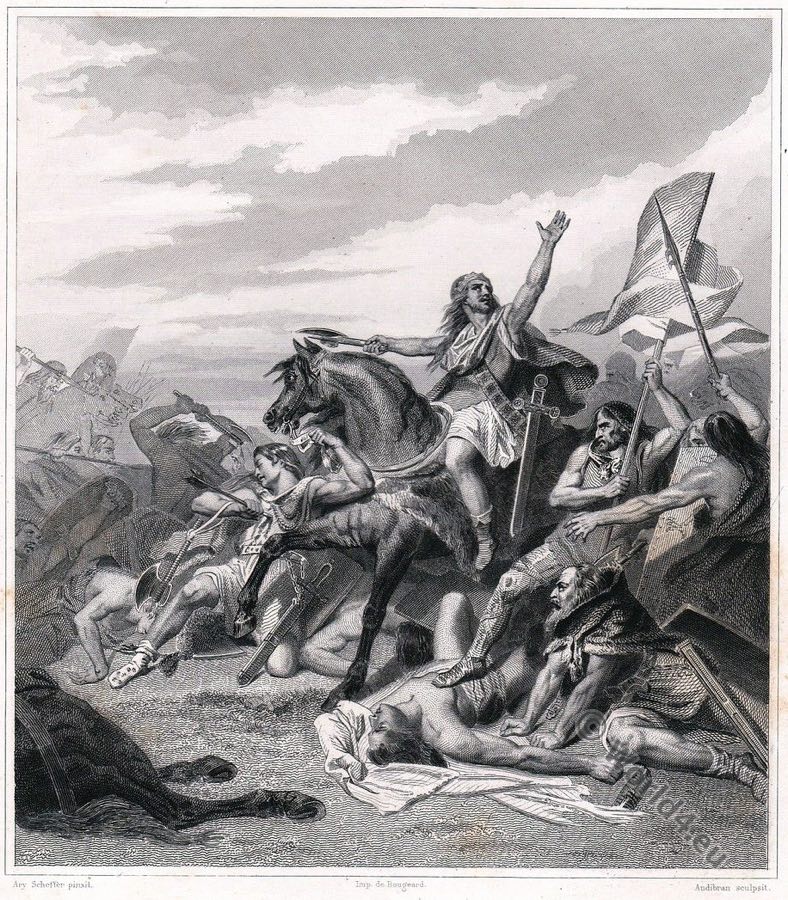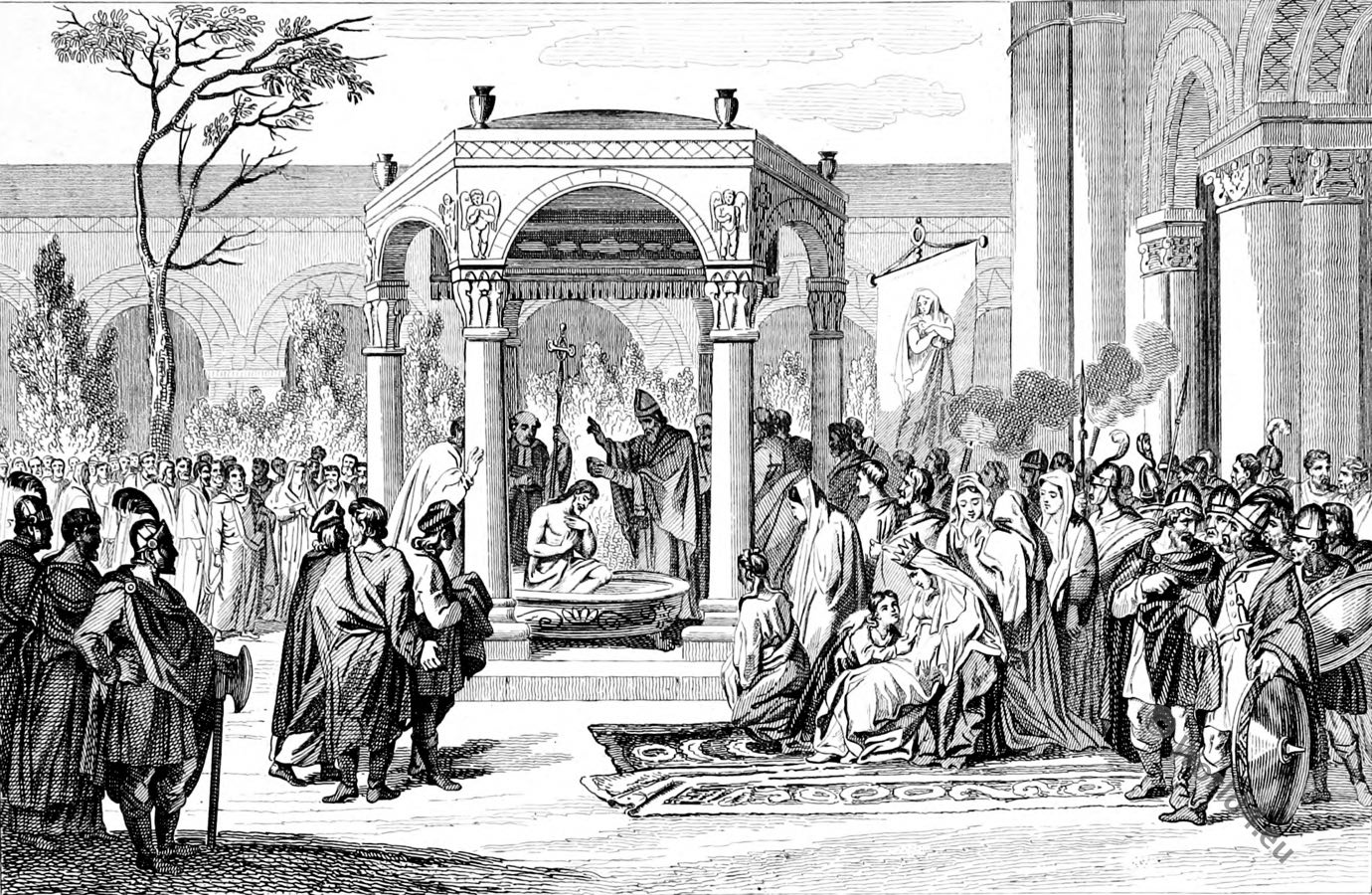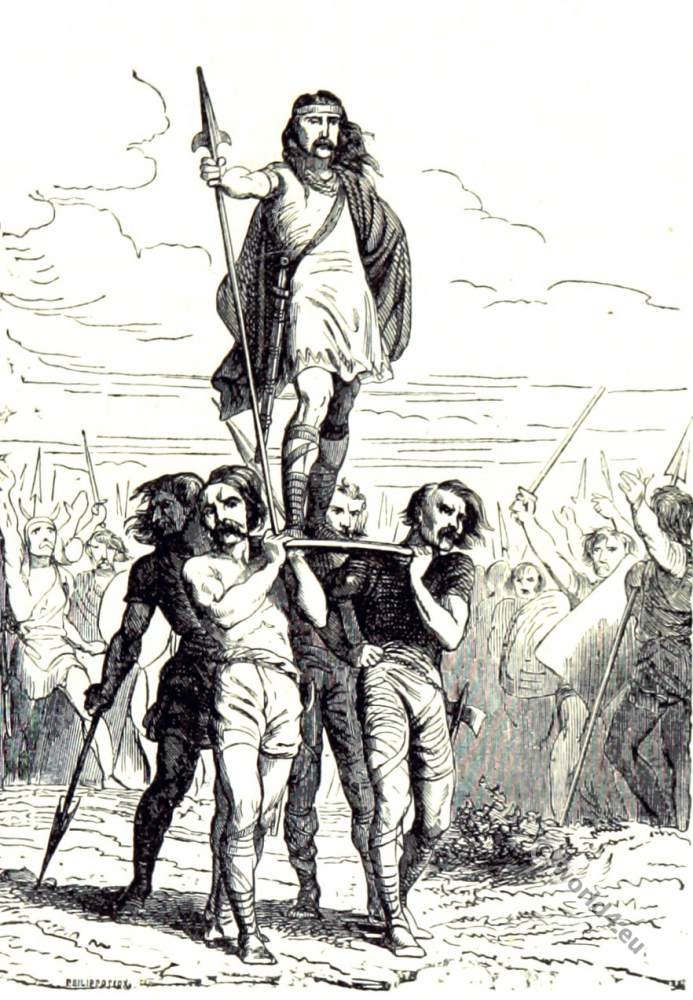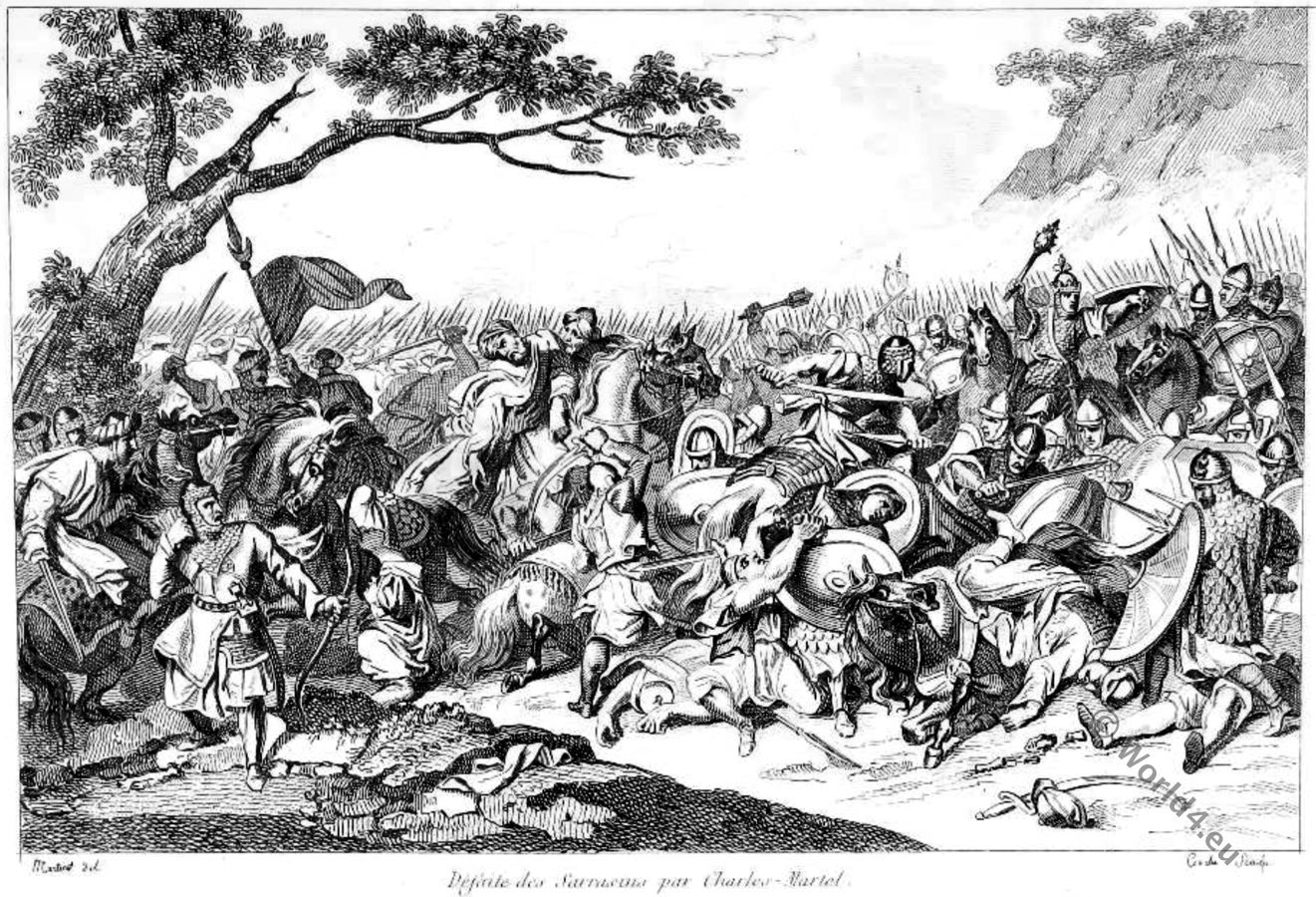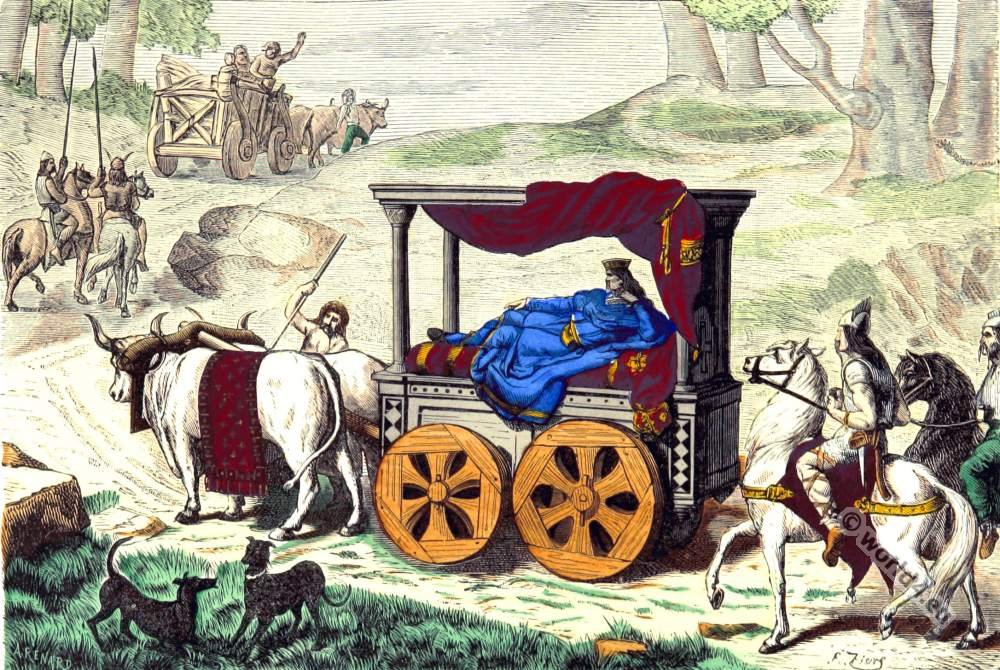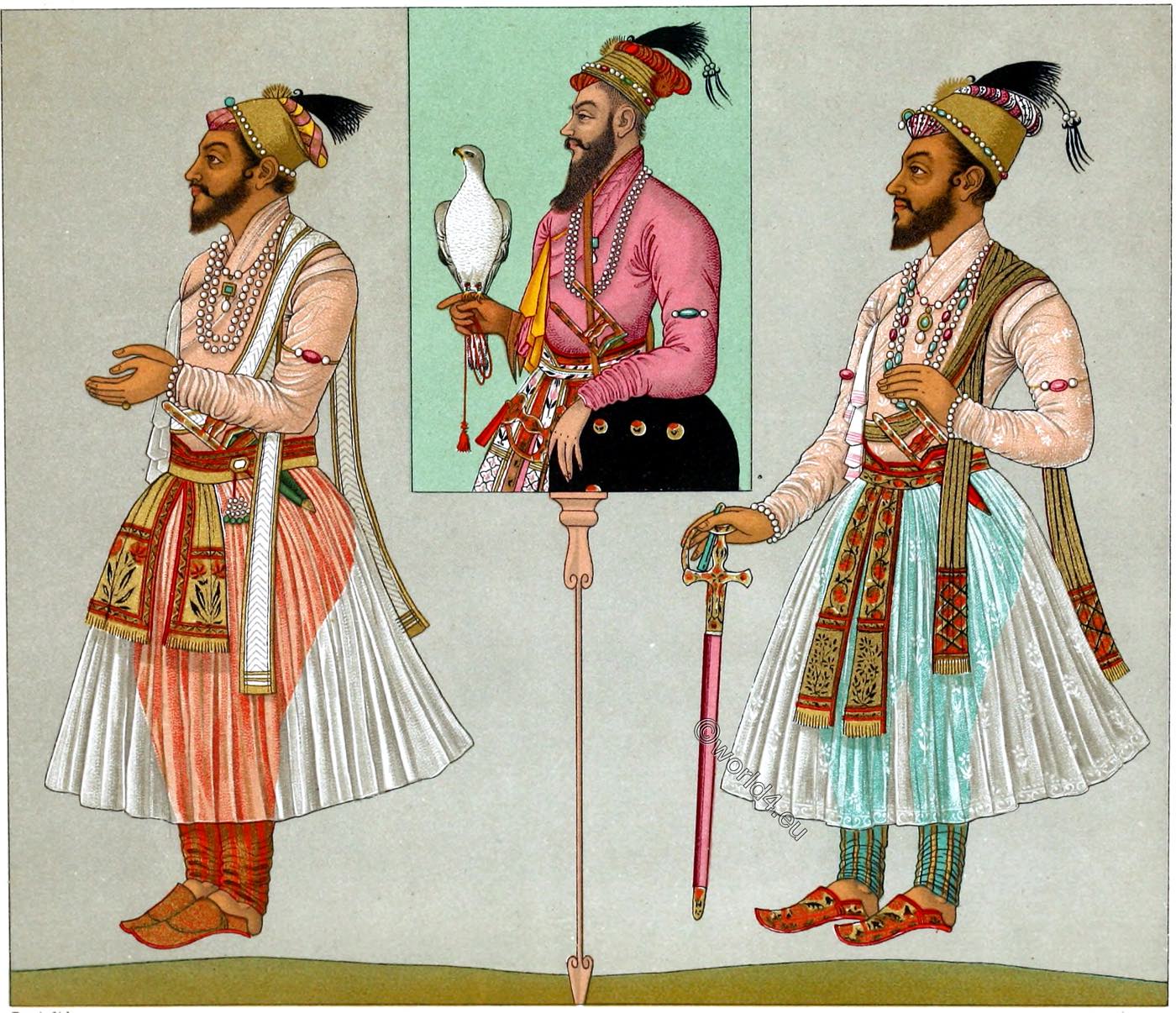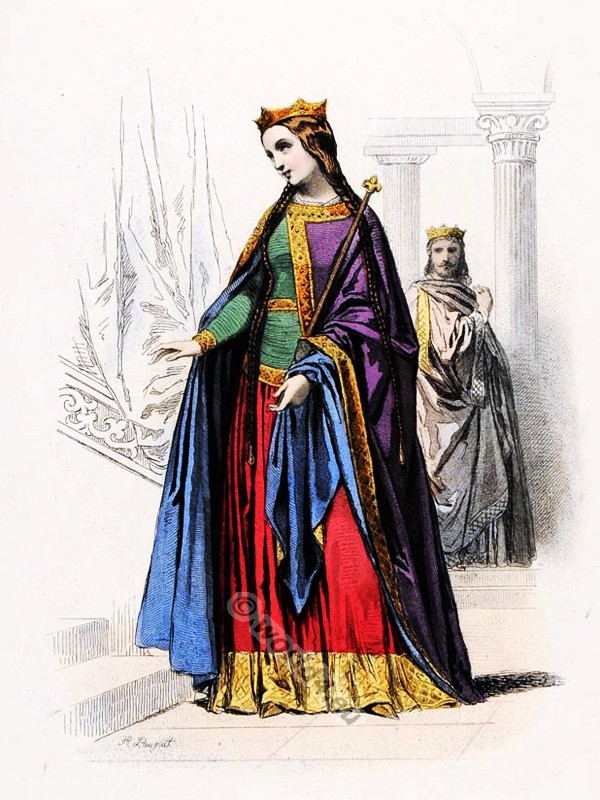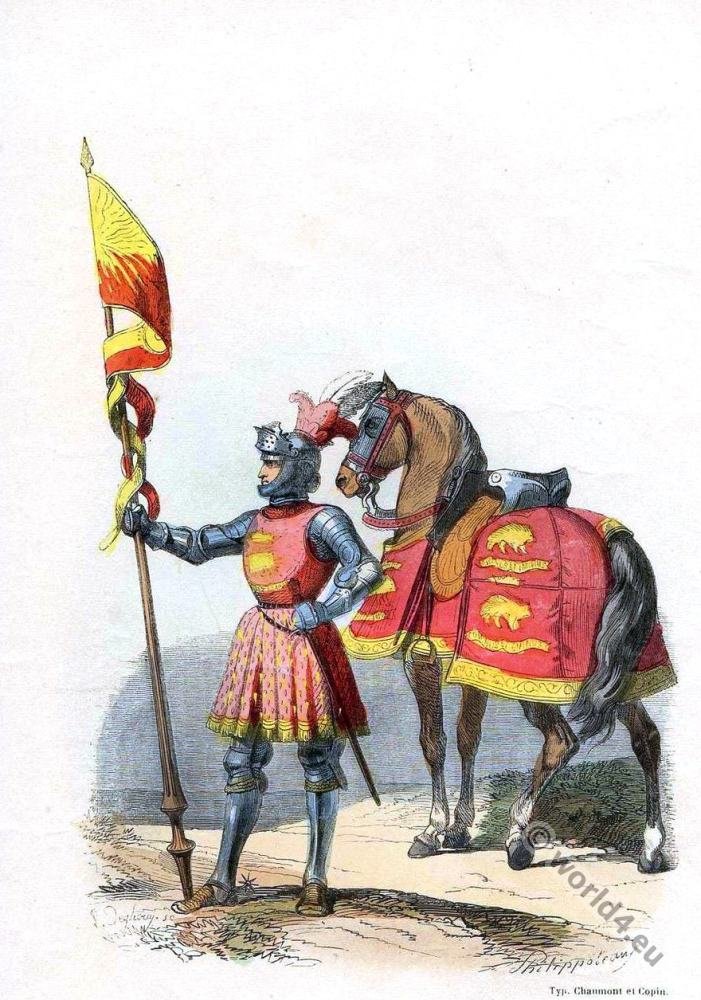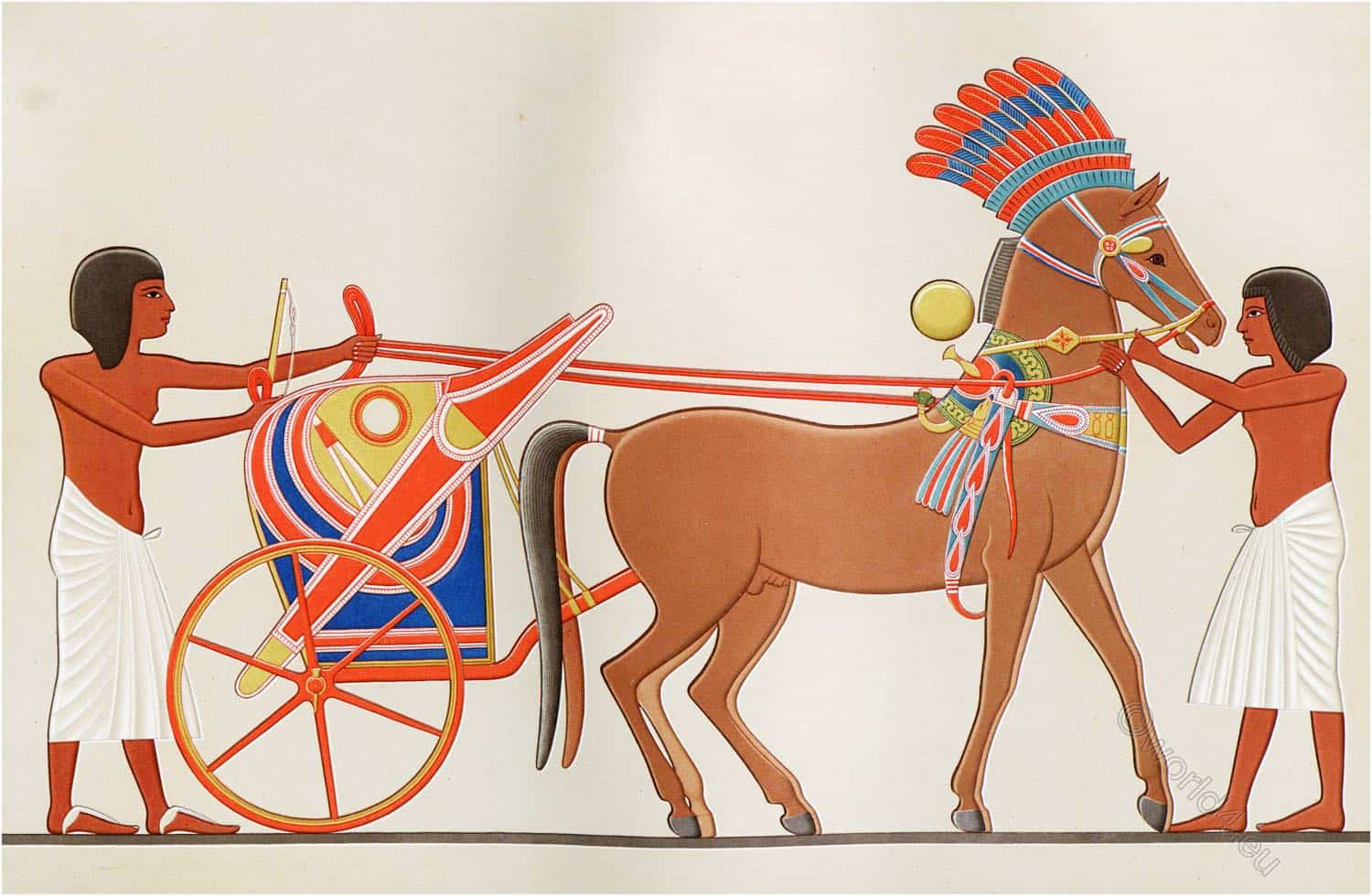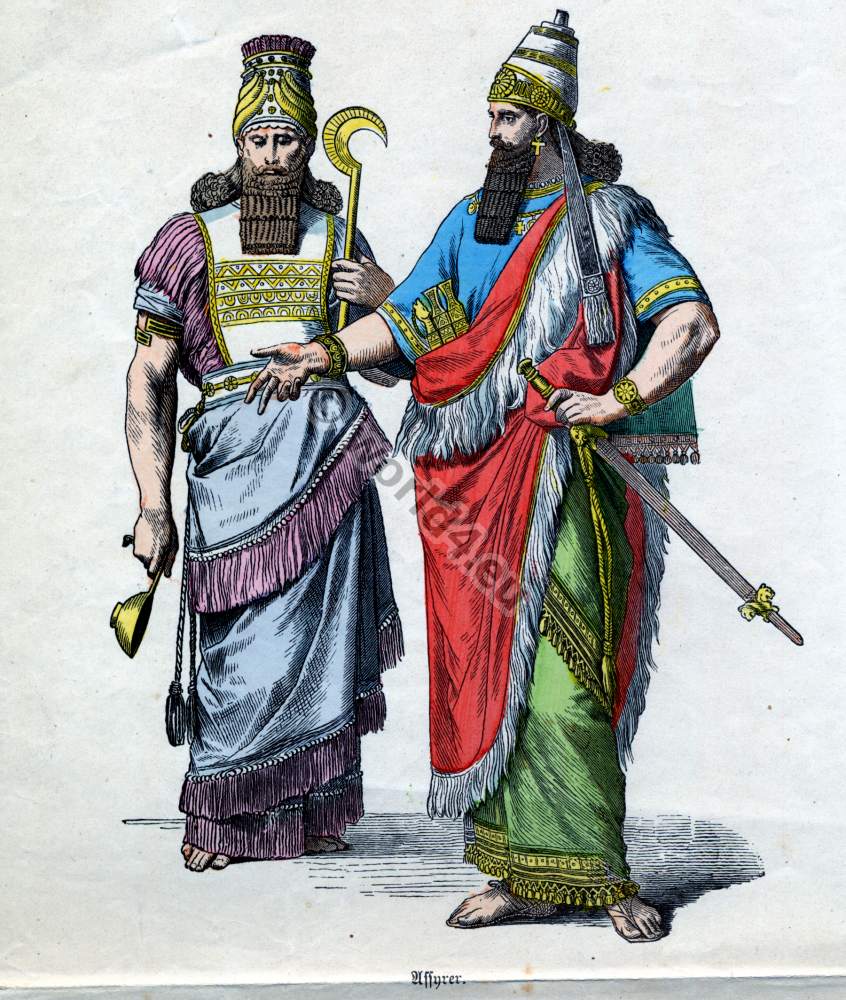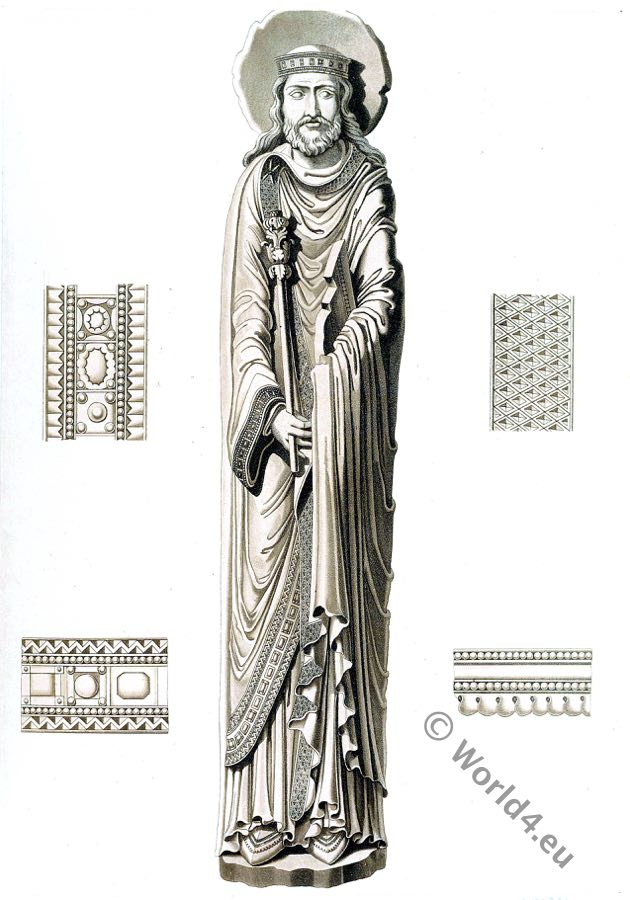
CLOVIS I. KING OF THE FRANKS.
FOR the preservation of this statue, and the one supposed to represent Clotilda the queen of Clovis, we are indebted to the zeal of Alexandre Lenoir, who placed them in his museum of national antiquities. They formerly stood, with four others, at the portal of the ancient church of Notre Dame at Corbeil, a town about twenty miles to the south-east of Paris. But their companions perished with the church they embellished, and these figures, the only remains of its former magnificence, have been transferred from the museum to be placed at the entrance to the vaults of the magnificent church of St. Denis, the resting place of the long line of sovereigns of whose power Clovis laid the foundation.

It is, however, a mere conjecture which has given to these two names of Clovis and Clotilda; a conjecture, too, which seems to have been made without any grounds to support it. Some antiquaries even went so far as to believe them to have been executed in the remote ages of the Merovingian princes: an evident absurdity. The church of Corbeil is said to have been founded in the latter part of the eleventh century; and the statues have every appearance of having been sculptured either then or early in the twelfth century. We have no information as to the character of the four statues which are destroyed.
The initial at the commencement of the present article is taken from a large MS. Bible of the twelfth century, now in the possession of Messrs. Payne and Fosse, and represents a favourite subject in the illuminations of that period, the combat between David and the giant Golias.
The pavement at the foot of the same page, from the Musée des Monuments Français, is also of the twelfth century.
The two musical instruments represented below are copied from the sculptures on the portal of the cathedral of Notre Dame at Chartres, and are of the twelfth century.
The Merovingian Dynasty.
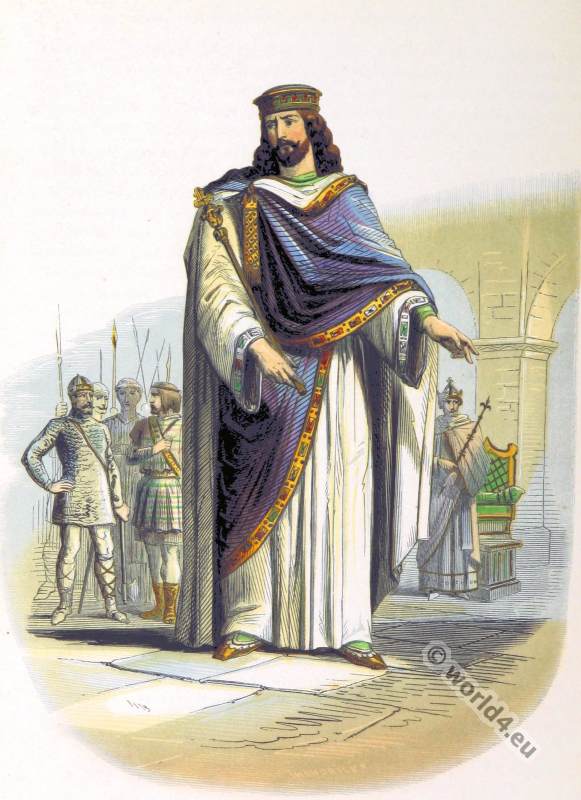

Clovis first king of the Franks. Ruler of the Frankish kingdom. Founder of the Merovingian dynasty.
Clovis reigned 30 years. From 481 to 511. Contemporary with the Heptarchy. (Heptarchy,- Greek for Seven Reigns, is a name for the young early medieval period, in which England was divided into Anglo-Saxon minor kingdoms.)
Kingdom. The only territory inherited by Clovis was West Flanders, the department called du Nord as far as Cambray, and that called Pas-de-Calais as far as the river Lys. But before the close of his reign his kingdom embraced all France (except Burgundy and the coast-land of the Gulf of Lyons), and all the territories lying between France and the Rhine.
Married. Clotilde, daughter of Chilpéric, king of the Burgundians, a zealous Christian, who induced her husband to be baptized. Issue. Thierry, Clodomir, Childebert, and Clotaire.
Royal Residence. The palace of Julian in the Ile-de-Paris.
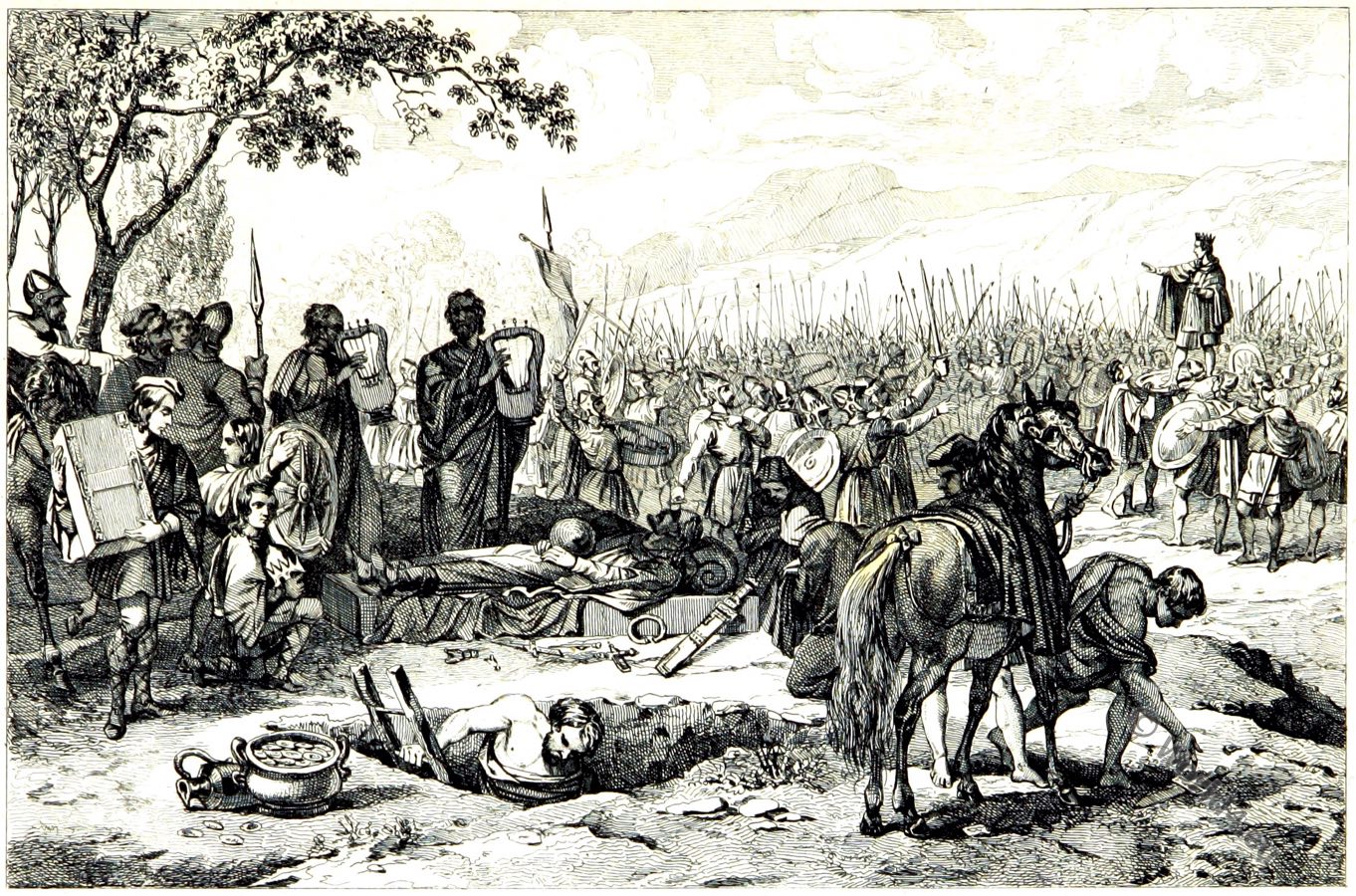
Clovis a corruption of Chlotwig, a compound of Chlot (celebrated) and wig (warrior). His father’s name Chilpéric is compounded of childe (lord) and ric (king). Lord Byron calls one of his heroes “Childe Harold,” equivalent to Lord Harold. Clovis, son of Chilpéric, and grandson of Merovaeus, was only 15 years old when his father died; but he was instantly raised upon a buckler in acknowledgment of his election to his father’s government. His whole territory was limited to the little kingdom of Tournay. Other clans of the same tribe were settled at Terouenne on the Lys, at Cambray, and at Mans on the river Sarthe [Sart.]
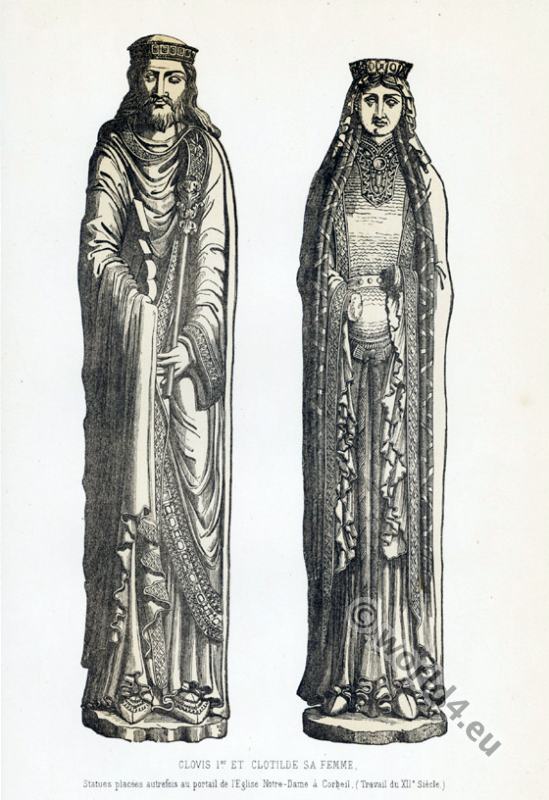
Beauvais, Soissons, Amiens, Troyes, and Reims [Rdh’nee], with their dependencies, were governed by Syagrius, the Roman, in defiance of the senate; and this was all that remained in Gaul, even in name, to the fallen empire of the west. (Syagrius was the last independent “Roman” ruler in Gaul (“Warlord”). In 486/87 he was defeated by the Frankish army commander and rex Clovis I in the battle of Soissons, and was later executed at his command.) Alsace and Lorraine, with a large part of Germany, belonged to the Alemanni; Armorica or Brittany, to the Bretons; all the south of Gaul, from the river Loire to the Pyrenees, to the West Goths; and the basin of the Rhone to the Burgundians.
Battle of Soissons (486).
Clovis first directed his arms against Syagrius, and defeated him in a battle near Soissons. After which he extended his kingdom to the banks of the Seine; moved from Tournay; and made Soissons the capital of his kingdom. As Syagrius, like his father, had been declared the enemy of the empire, the news of his defeat was very acceptable to the Roman senate, which conferred upon the conqueror the titles of consul and patrician.
Battle of Tolbiac (496).
His next expedition was against the Alemanni, whom he repulsed with great slaughter at Tolbiac, now called Zulpich, near Cologne; and compelled the cession of all their territories between the Moselle and the Rhine. It was in this engagement he made a vow, while his soldiers were wavering, that if the God of his wife Clotilde granted him the victory, he would become a Christian. When the blood-stained warrior, after the battle, presented himself in the cathedral at Reims, with his sister and 3000 of his followers, the aged prelate said to him “Sigambrian, henceforth shalt thou burn that which thou hast worshipped, and worship that which thou hast despised.”
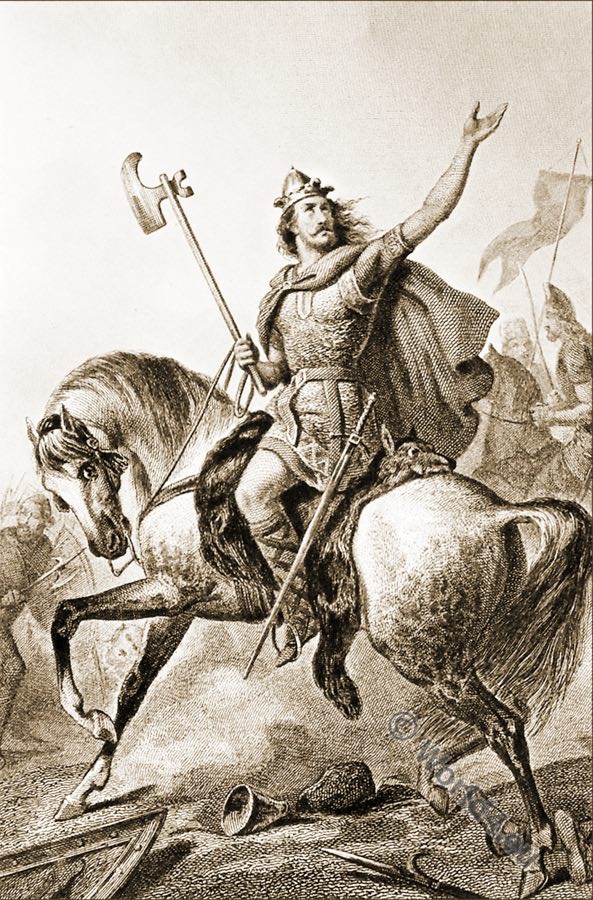
Sigambrian. The Sigambri were the chief tribe of the Salian Franks.
We are not to suppose that any change of heart had taken place in Clovis, but it is quite certain that no act could have been more politic. The pope Anastasius saluted him as “The most Christian King;” and the clergy were glad to play him off against the other princes of Gaul, who were of the Arian heresy. From this moment his success was rapid and almost bloodless. All the cities of the Loire, except those of Amorica, opened their gates to him; and he ruled from the Loire to the river Rhine.
Defeat of the Burgundians (501).
His third great expedition was against the Burgundians, to which he was urged by the bishops of that country. The ostensible plea for this aggression was vengeance against Gondebaud, their king, for having murdered Chilpéric, the father of queen Clotilde; but the real cause was the hatred of the clergy against him, because he was an Arian. Gondebaud was easily vanquished; and the only terms imposed upon him were that he and all his subjects should renounce their heretical opinions, and return to the bosom of “holy church.” By this treaty the authority of the pope was restored in all the cities lying between the Rhone and the Saone [Sone]. The kingdom of the Burgundians continued only 33 years longer, and was then seized upon by three of the sons of Clovis and divided among them.
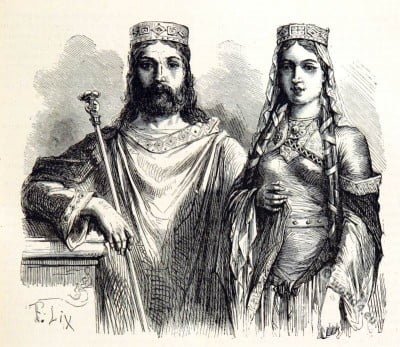
Battle Of Vougle’ (507).
On a similar pretence of zeal for the church, Clovis next attacked Alaric II., king of the West-Goths, who claimed dominion of all the south of France, west of the Rhone up to the river Loire [Lwor]. “It is very annoying,” said he to his warriors,” that these heretics should occupy all the garden-land of Gaul; let us up and drive them out.” This speech was received with acclamations; and the army followed their favourite leader to Vougle, near Poitiers, where Alaric had halted to give him battle. The struggle was fierce and sanguinary; Alaric was slain; and the whole territory of the West-Goths in Gaul, was added to the kingdom of the Franks.
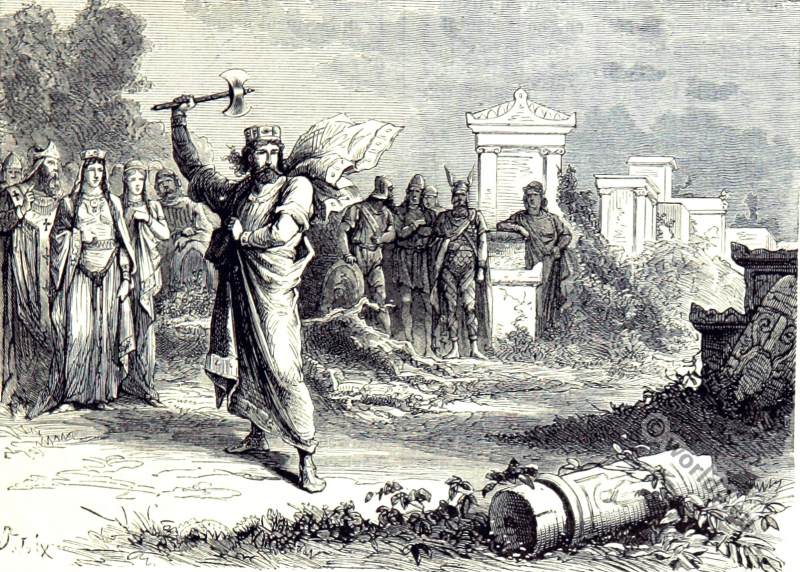
Next year Theodore the Great, king of Italy, marched against Clovis, to avenge the death of Alaric his son-in-law; and a battle was fought at Arles [Arl], in which Clovis was defeated (508). By a treaty of peace the West-Goths were now allowed to retain all that strip of coast which forms the gulf of Lyons, from the mouth of the Rhone to the Pyrenees; but all the rest of their territory was given up to Clovis. (The West-Goths continued to retain this grant for 222 years, when Charles Martel drove them wholly out of France. Some years later they returned to their old quarters, and were finally expelled by Pepin in 759.)
CELEBRITIES IN THE REIGN OF CLOVIS.
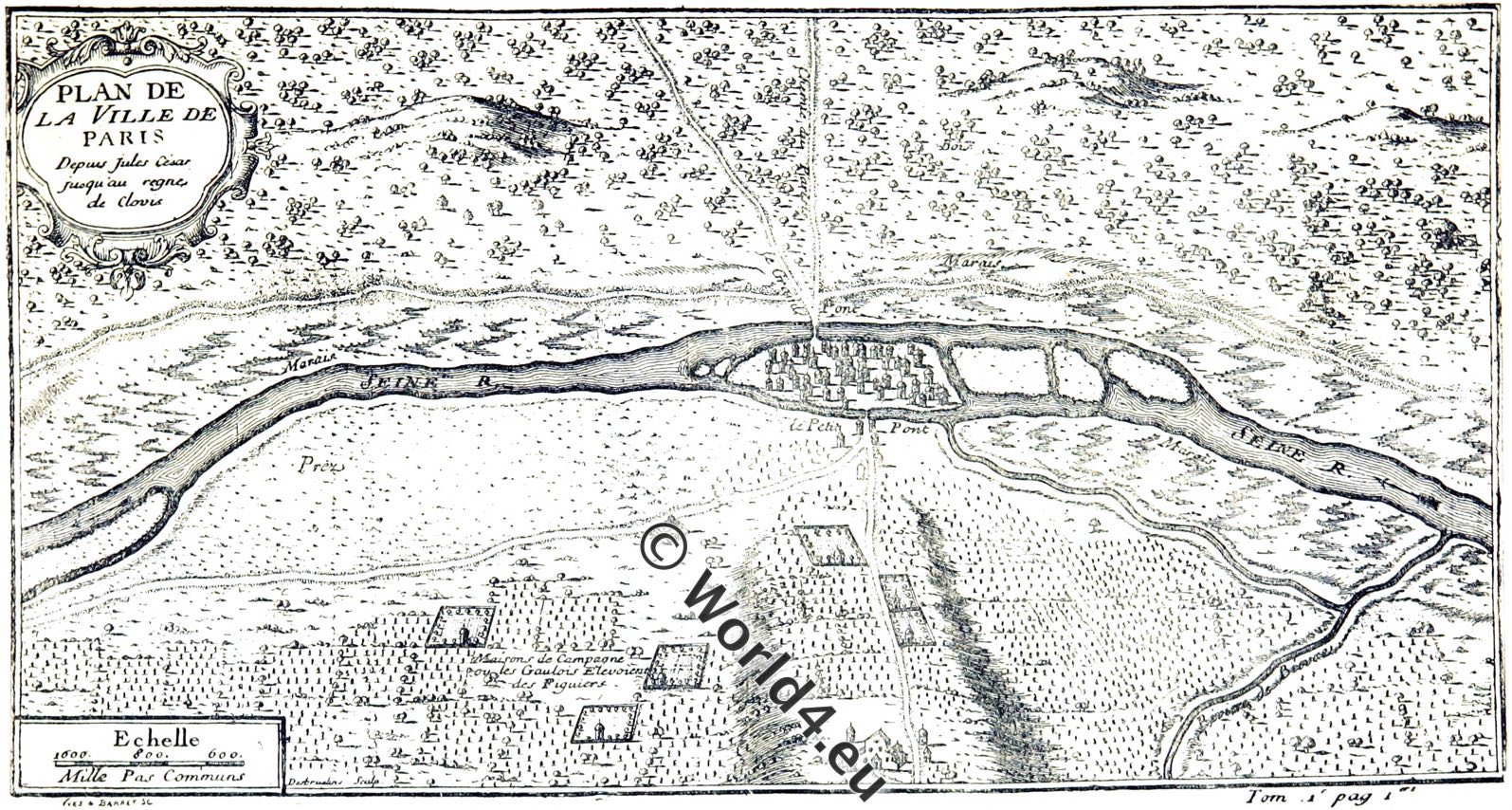
St. Genevieve (423-512), the patron saint of Paris, was by far the most important person in the reign of Clovis. She was born at Nanterre, near Paris; and followed in early life the simple occupation of a shepherdess; but at the death of her parents, removed to Paris; consecrated herself to God ; and lived a life of great piety and abstinence.
When Attila invaded Gaul, the Parisians were panic-struck, and would have abandoned their city, had not Genevieve restrained them, by “predicting that Paris would be spared.” Attila certainly withdrew his forces without attacking the city; and the Parisians ascribed their safety to her prayers. Somewhat later the same people were visited by a dearth; and, according to tradition, this visitation also was removed by the intercessions of the Nanterre shepherdess. St. Genevieve died at a very advanced age, and was buried in the church which Clovis had built; where for several centuries her relics were annually exposed to view on the 3rd of January. On the destruction of this edifice, they were removed to the church called St. Etienne-du-Mont, where they are still preserved; and for eight days every year are visited by immense crowds. St. Genevieve being canonized, was made the patron saint of Paris; and, in times of great distress, or when some extraordinary favour is to be sought from heaven, her image is carried in procession with great pomp and ceremony.
EFFECTS OF THE GERMANIC INVASIONS.
The institutions, habits, and organization of the Franks in Gaul, must not be inferred from those of the same race in their native land. The position, wants, and constitution of the two people were totally different; and it would have been impossible to transfer to a war-faring band in a foreign country, the laws and customs of a nation settled and established. Hence a very common error is to be guarded against, that of presuming the Franks in Gaul to be the counterpart of the Franks in Germany.
The Franks in Germany had their chiefs, their leudes or thanes, their staff or antrustions, and their civil judges or mord-domes; but in Gaul they must have resembled, in a great measure at least, a bandit or free company. The king or captain of a band had no regal rank or prescriptive authority. His followers were not his subjects, but his companions; who ranged under him of their own accord; left him when they liked; and undertook no expedition against their will. In such a society there must of necessity be much of the spirit of clanship, a very loose moral discipline, a strict military one, and a prodigality in the leader more binding than law. Of course pillage would be the prime object of such adventurers; and though the leader would take the largest share, he would not of necessity be the richest man, as he would be expected to reward every service with ungrudging liberality.
When Clovis became master of Gaul, his chief followers would gradually become the proprietors of the soil. He would reward from time to time his distinguished warriors with grants of land, called fees. The persons thus provided for would depart to inhabit their tenement, carrying with them a host of companions and retainers. A village would gather round the great house, not a village of free cotters, but one of the labourers and servants employed upon the estate. The operation of such a system in a few years would be felt in the following manner:
(1) The leader or captain, being no longer kept in check by his great warriors, would grow more arrogant; and the royal principle would be rapidly developed.
(2) The feofees would grow into a landed aristocracy, powerful, wealthy, and ungovernable.
(3) The people, dispossessed of their estates, robbed and plundered without redress, and cared for by no one, would sink lower and lower, and become more abject and servile, as the line between them and their foreign lords became more broadly marked.
(4) Lastly, the unity of the original band would be broken up. Each landed proprietor would have his own separate interest. And the nation would become an ill-cemented throng of isolated lords, apt to be disturbed whenever one more ambitious than the rest chose to make aggressions. The following anecdote will shew how limited was the kingly power of Clovis. After the Battle of Soissons, he wished to appropriate a valuable vase, but one of the warriors stepped forward, and broke it to atoms with his battle-axe, saying, “Thou shalt have thy share only, like the rest of us.” Clovis dissembled his anger, but did not forget the insult; and one day finding the same warrior had neglected to clean his axe, snatched it out of his hand and split his skull, saying, “Remember the vase of Soissons.”
THE INFLUENCE OF THE CHURCH IN THE BARBARIAN PERIOD.
The only power which struggled against barbarism, and the only check upon the fierce passions of the conquerors, was the church. The bishops were the natural chiefs of the large towns. They governed them as magistrates; protected them by their power; and represented them before the barbarians. When Clovis was baptized they became his chief counsellors, and advised him how to act towards the vanquished people; and thus were they the moulders of the nascent royalty. A third position now opened to them, that of landed proprietors. They shared with the warriors in the possession of the soil. Thus was their influence three-fold: They were the advisers of the crown; the protectors of the people; and the rivals of the warrior chiefs. There can be no doubt that in those times they were the salt of the earth. They were the most learned, intelligent, and experienced body in the nation; and their influence on a whole was directed to laudable objects.
Prosperity and power, brought with them their usual consequences, arrogance and corruption. And later kings had to do battle with the church, not for its defence of liberty and letters, but for its obstinate resistance of progress, and its efforts to enslave. Of course the wild hordes which were baptized in masses without having received religious instruction, could know very little of the doctrines and spirit of Christianity. They had been brought up in idolatry; and naturally looked upon God as a sort of Odin, and Jesus Christ as a deified hero. They treated their new “deities” according to their knowledge; and when they acted wickedly thought to avert their displeasure by bribes. Hence their lavish presents to the clergy, their magnificent churches, and their religious foundations. Being wholly unable to write and read, the clergy had to instruct them by sensible objects; and hence the pomp and pageantry, the signs and symbols, the carnal threats and promises, introduced. To us who have been taught from infancy the simplicity and spirituality of the gospel, this show and grandeur seem inconsistent; but they were not without their wholesome influence among those gross and barbarous people.
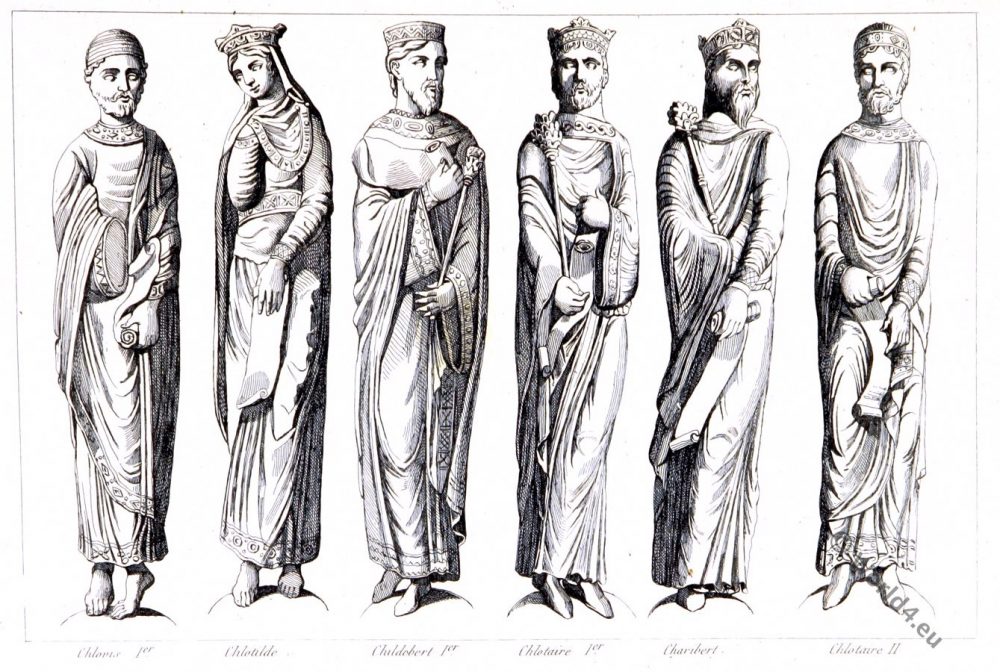
Monuments des Rois Merovingiens. Clovis 1er, Chlotilde, Childebert 1er, Chlotaire 1er, Charibert, Chlotaire II
Merovingian kings.
DYNASTY OF CLOVIS. FROM 511 to 638.
The rest of the Merovingian dynasty, except Dagobert, were utterly worthless; and the only incidents recorded in their reigns are sanguinary quarrels, family feuds, murders, wars, and crimes too odious to deserve relation. It was customary among the Franks for all sons, at the death of their father, to share alike; consequently, every time a king died, leaving two or more sons, his kingdom was divided, and a civil war ensued.
Clovis left four sons, each of whom had his separate court and seat of government: Thierry, the eldest, resided at Metz [Mess]; Clodomir at Orleans; Childebert at Paris; and Clotaire, the youngest, at Soissons [Swois-so’ng]. Of these four, Clodomir died first, leaving three infants; two of whom were murdered by their uncle Clotaire; and the other, Cloudoald, made his escape and became a monk. Afterwards he founded a monastery near Paris; and both the monastery and the suburb in which it stood were called by his name, since shortened into St. Cloud [San Cloo]. Soon after the death of Clodomir, the three surviving brothers combined against the king of Burgundy; dethroned him; and partitioned his dominions among themselves.
Clotaire, the youngest, outlived his brothers, and re-united the kingdom for a short time; but as he left four sons, the contentions and crimes of the last half century were again repeated with very little variation. Of the three sons of Clotaire I., the eldest soon died; and the entire kingdom was divided into three parts called Neustria, Austrasia, and Burgundy. Neustria, or the new kingdom, was all that part of France encompassed by the Loire and the Meuse (supposing them joined together), and excepting the peninsula of Bretagne (Bre-tan’y).
Neustria was in the period from 511 to 737 the north-western part of the Frankish kingdom between the Loire and Scheldt. The Merovingians were the masters of this realm. In the course of his existence, Neustria often had conflicts with his eastern neighbor Austrasien, but these two countries were often associated with each other in personal union. Neustria was the realm of Soissons and predecessors of the West Franconian Empire. His chiefs all bore the title of king. Austrasia, or the eastern kingdom, lay east of the river Meuse. Lorraine and Alsace, with Bavaria, Barden, and Wurtemburg, formed this kingdom. Subsequently it was enlarged by the addition of all the south of France, bounded by the Garonne, and carrying the branch, called the Tarn, up to the river Rhone. Austrasia (the land in the east) had been a self-sufficient Franconian kingdom since the death of Clovis I in 511 to Pippin the Younger, first with the capital Reims and later Metz. In the beginning this kingdom was also called the kingdom of Metz, until the name Austrasien came into existence from 584 onwards. The area covered the Franconian areas around the Rhine, the Meuse and the Moselle, and, besides Metz, the towns of Reims, Cologne, and Trier, and the territories of the defeated Germanic tribes.

Pepin the Short 715-768 from the Carolingian family and since 751 King of the Franks. He was the son of Charles Martell and the father of Charlemagne. Bertrada of Laon c. 725-783 Queen of the Franks, wife of Pepin the Short and the mother of Charlemagne, Carloman and Gisela.
Pépin “Le Bref” de FRANCIE III 715-768. Bertrade de Laon “Berthe au Grand Pied” de FRANCIE (née de LAON c. 725-783. Fille: Charles “Charlemagne” I., Carloman I., Pepin de FRANCIE, Gisèle de FRANCIE, Gertrude de FRANCIE, Berthe de FRANCIE, Rothaïde de FRANCIE, Adélaïde de FRANCIE.
Under the Austrasian King Dagobert I, the Lex Ripuaria (also Lex Ribuaria), which includes a collection of Latin law texts of the Rhine francs, was created in the Rhine-Franconian region at the beginning of the 7th century. At the accession of Charlemagne the name of Austrasia was lost; and that of Neustria in 843 at the treaty of Verdun. Austrasia merged into Germany, and Neustria into France. NEUSTRIA is Neust-reich [new kingdom]. AUSTRASIA or rather Ostrasia is Oster-reich [east kingdom].
Fredegonde and Brunehaut. The only incident worth mention during the reign of the three sons of Clotaire I. is the hatred which subsisted between the kings of Neustria and Austrasia, fomented by their wives Fredegonde and Brunehaut [Bruno]. This hatred gave rise to an intestine war, which for half a century desolated France, led to numerous murders, and brought about the death of both the queens. Fredegonde, having invaded the kingdom of Austrasia, gained a complete victory; but died a few days afterwards either by poison or the dagger.
Brunehaut survived her rival 16 years; when she was seized by Clotaire II., the son of Fredegonde; and being lashed to the tail of a wild horse, was kicked to death by the infuriated animal. This remarkable woman, who had for 48 years been the terror of her enemies, united to an active and powerful genius, the most towering ambition and unflinching recklessness of purpose. Her crimes were frightful; but she was a great promoter of the arts; caused several roads to be constructed; built a prodigious number of churches and monasteries; and tried, not without success, to introduce into Gaul the Roman laws and literature.
Clotaire II. (584 to 628), son of Chilpéric and Fredégonde, succeeded to the kingdom of Neustria at four months old, but ultimately united for the third time all France under one sceptre. The greatest event of his reign was the royal ordinance which rendered the mayors of the palace a permanent appointment. These Mayors were the chief judges or magistrates of the nation ; and after the reign of the next king, the whole power of the state passed into their hands.
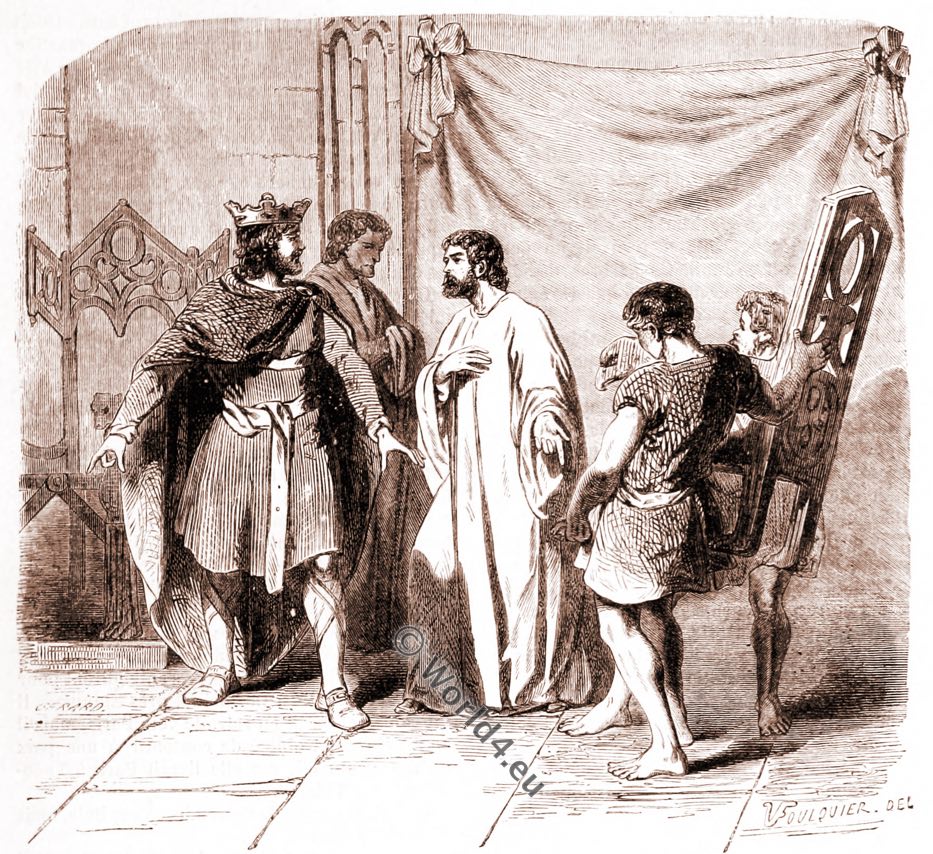
Dagobert was amazed when Éloi presented him with the second chair. Dagobert fut émerveillé quand Éloi lui présenta le second fauteuil. (Source: Paris à travers les siècles. Histoire nationale de Paris…)
Dagobert I. (628-688) his son, succeeded next, the wisest and most redoubtable of all the descendants of Clovis; but, like several others of the same race, he united to great religious zeal a cruel and licentious disposition. He made enormous gifts to the clergy; filled France with his churches and convents; lived in eastern pomp and splendour; and had his court crowded with bishops, nobles, and foreign ambassadors. Amongst other foundations he built and endowed the rich abbey of St. Denis [San Dneé], near Paris, celebrated as the place of sepulture of the French kings. St. Éloi* was his friend and minister.
* The Holy Eligius (lat. The Chosen One, also Eulogius, French: Saint Éloi) at 589-659, 660? Was Bishop of Noyon. His relics are in the cathedral of Noyon. Another is admitted in the bust of St. Eulogius in the parish church in Aftholderberg (Germany).
LES ROIS FAINEANTS, THE PUPPET KINGS. FROM 638 TO 742.
Clovis II. and his ten successors were so utterly worthless, that they have gained for themselves the ignoble appellation of the “Good-for-nothing kings” (les Rois Fainéants). These kings were all parents at 15, and old men at 30, to which age only one of them attained. Clotaire IV. died at the age of 12; Clovis III. and Dagobert III. at 15; Clotaire III. at 18: Chilpéric II. at 20: Clovis II. at 23: Thierry IV. at 25; Childerbert II. at 28; and Thierry III. was the only one who outlived 30. Fainéant (fain’-yarn) is from faire-neant, to do nothing. Mayors Of the Palace. The whole power of the kingdom during this century was vested in the mayors of the palace, originally superintendents of the household, and stewards of the royal leitdes or companies. Being also chief magistrates they were called Mord-domes, that is, judges of murder. The word mord-dome was corrupted by the Romans into Major-domus, and the Latin corruption, retranslated into French, became Maire-du-Palais. From being the king’s chief man, who superintended all his house, the palace-mayor became the head of the aristocracy; and ultimately greater than even the king himself. The most celebrated of these officers are the two Pepins, Ebroin, and Charles Martel.
(1) Pepin de Landen (613-649) generally called Pépin the Elder (le vieux), was palace-mayor during the reign of Clotaire II., Dagobert I., and the minority of Sigebert II. He was so virtuous a magistrate, that at death he was canonized.
(2) Ebroin (656-681). At the decease of Clotaire III., all France, was united again in the person of his brother Childéric. Ebroin, a man of infamous character and most despotic temper, was at the time the palace-mayor of Neustria. The nobles of Austrasia revolted against his tyranny; separated from the united kingdoms of Neustria and Burgundy, and placed themselves under Martin and Pepin the Fat, his cousin, a grandson of the other Pepin, whom they created their leaders or dukes. Ebroin lost no time in crushing this revolt; the army of the two dukes was defeated, and Martin put to death. Pepin escaped and raised another army; but while Ebroin was on his way to give him battle, one of his own officers cleft his head open with his sword, and left Pepin without a rival.
(3) Pépin d’Heristal (681-714), surnamed The Fat or Corpulent, now caused himself to be proclaimed the palace-mayor, and in this capacity ruled both kings and subjects for 32 years with absolute sway. He placed successively on the throne Clovis III., Childeric III., and Dagobert III. But in order to mask his power, revived the Assembly called the Champ de Mars which had fallen into disuse. (Champ-de-Mars pronounce Sharnd-Mars’. After 755 these Meetings were held in May, and called Champs-de-Mai [Sharnd-May’}. Napoleon I. revived them in the “Hundred Days.” (1 June 1815). These March-meetings had been held by Clovis and his immediate followers sometimes as mere pageants, such as military reviews, for the amusement of the freemen who came to offer homage to their lord, and pay him their annual gifts; sometimes they were made use of for business purposes, especially when the king wished to consult his great warriors about some intended expedition, or his bishops about some affairs of state.
Pépin the Fat revived them solely for the purpose of ceremony and amusement. The nobles and great vassals came to do homage and offer gifts; and the king in his robes of state was drawn to the place of muster in his ox-chariot, took his seat on a golden throne, gave audience to ambassadors, made a set speech, and returned home again to exercise no other royal function till the next annual show-day. Pepin died at a very advanced age. He was called Héristal from his palace of Héristal on the Meuse.
(4) Charles le Martel (714 – 741), a natural son of Pépin d’Heristal was next created duke of Austrasia and palace-mayor. The murder of Dagobert III. freed him from his only rival. He brought Chilpéric II. from a cloister to place him on the throne; but the child had the folly to quarrel with his minister, and even tried to disseat him. Charles now took up arms; surprised the royal camp, as it passed through the forest of Ardennes [Ar-denn]; and, in the battle which ensued the next day, entirely defeated the king’s forces. Upon this, Chilpéric entered into an alliance with Eudes [Ude], by ceding to him the kingdom of Aquitaine. Charles, however, placed on the throne another of the royal family named Clotaire, advanced against Chilpéric and Eudes, and entirely defeated them near Soissons. After this disaster Eudes, despairing of success, delivered up Chilpéric into the hands of his antagonist. Charles treated him with the greatest courtesy, and even restored him to the throne after the death of Clotaire.
In 731 Duke Eudo of Aquitaine was threatened by the Arabs, and applied to the palace-mayor for aid. Charles readily responded to this appeal; and the encounter which ensued has placed his name amongst the foremost of the world’s great warriors. (Since the 1990s, voices have become more and more important, which are relativizing the importance of Karl’s slaughter. The success is seen as a defense against a movement that is already altogether sloping.) Never since the time of Attila had so formidable a host appeared in Gaul. Narbonne [Nar-bonri] had succumbed already, and now Aquitaine was threatened. Duke Eudo of Aquitaine collected an army; but the Saracens utterly routed it, and marched without further resistance to Bordeaux, which they consumed by fire. While they were still revelling in the spoils, Charles halted on the plains of Poitiers. A great question was at stake, whether Europe was to acknowledge the crescent or the cross.
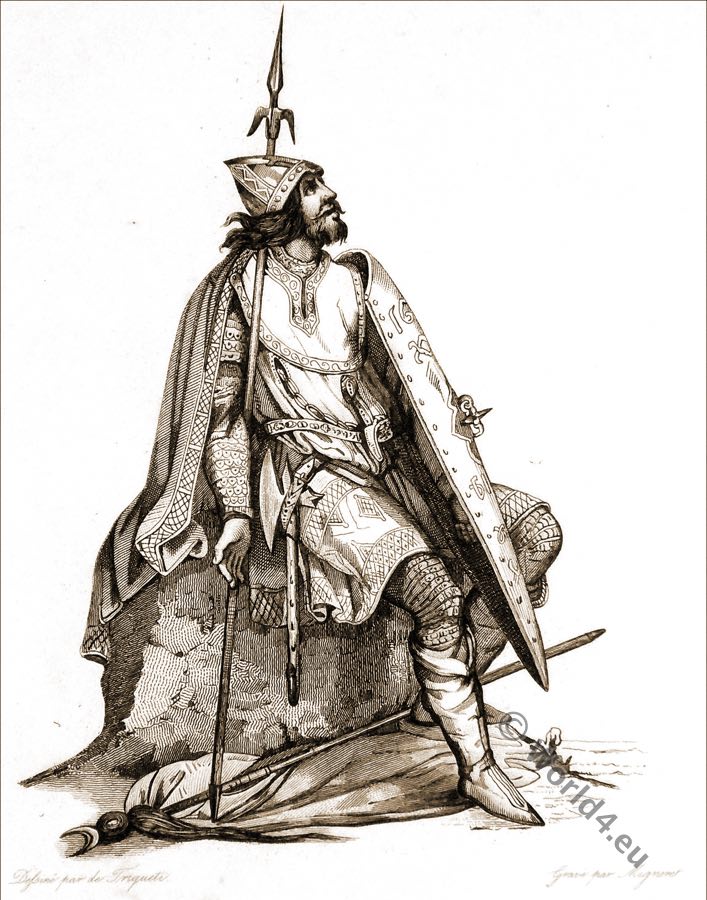
If the Saracens prevailed, the Muhammadan religion would have been forced upon the people; and probably other nations of Europe would have been subjugated by the same power. If the Franks prevailed, the Christian religion would continue dominant; and the power of Mahomet in Europe be crushed for ever. Never was the issue of a battle more important. For seven days the two armies watched each other’s movements without striking a blow; but at length the engagement began. The Saracen leader was Abd-el-Rahman, viceroy of Spain, who began the battle with his light cavalry. The Franks on their powerful horses received the charge without flinching; and, defended by their heavy armour, stood like a wall of iron.
Duke Eudo of Aquitaine at this moment appeared in the enemy’s rear, and fired their camp. The Saracens were panic-struck; gave way; and Charles commanded his soldiers to advance. Abd-el-Rahman in vain attempted to rally his troops; they fled in every direction; Abd-el-Rahman was slain; darkness alone put a stop to the carnage; and next morning no trace of the Mohammedan could be found, except in the heaps of slain which covered the whole field (732). This was a really great victory; and Charles, who knocked down the foe and crushed them beneath his axe, as a martel or hammer crushes what it strikes, received the surname of le Martel, the hammer (Judas Asmonaeus was for a similar reason called Maccabaus, the hammerer.).
It is said that 300,000 Saracens, and only 1500 Franks, fell in the encounter, but this doubtless is a gross exaggeration.
Karl Martell was later exalted as a savior of the West because of the victory. However, the battle in contemporary sources was not regarded as an outstanding event, but only incidentally mentioned, which makes the reconstruction of the operations very difficult. In mediaeval historiography the Battle of 732 was less important than in modern times. The battle was only stylized into a world-historical event in modern times. In Arabic, the battle is also called Battle of the Balat-ash-Shuhadā’ (“Battle of the Martyrs”.
Battle of Tours also called the Battle of Poitiers on 18th or 25th October 732.
Franks and allies under the command of Karl Martell. Troop strength 15,000 men. 1000-2,000 dead. About 4,000 wounded.
Moors under the command of Abd ar-Rahman, Governor-General of al-Andalus. Troop strength 20,000 men. About 5,000 dead and about 5,000 wounded.
Source Wikipedia
Charles Martel lived nine years longer, all-powerful and allhonored. He defeated the Bavarians by land, and the Frissons by sea; triumphed twice over the Alemanni, and five times over the Saxons. Though not king in name, he disposed of the kingdom at death to his three sons, Carloman, Pépin, and Grifon. Grifon, the youngest, was seized by his brothers, and confined in a monastery. Carloman, the eldest, reigned 5 years, and then abdicated; leaving Pépin, surnamed The Short (le Bref), sole ruler of France.
CELEBRITIES IN THE REIGNS OF THE ROIS FAINEANTS.
St. Eloi (588 – 659), the “patron saint of smiths and artists,” lived in this period. He was master of the mint in the reign of Clotaire II., and the intimate friend of the 1st Dagobert. He carried the art of working in the precious metals to great perfection; and several specimens of his skill are still extant: such as the bas-relief on the tomb of St. Germain, bishop of Paris; several gold and silver shrines; and a golden throne enriched with precious stones, made for king Clotaire. Disgusted with the world, he retired to a monastery; from which he was afterwards drawn to preside over the see of Noyon; in which high office he acquitted himself with such piety and judgment, that he was canonized after death. Dunkirk or Dune-kirk, according to tradition, receives its name from the kirk or church built by St. Eloi on the dunes or hills.
LITERATURE IN FRANCE PRIOR TO THE REIGN OF CHARLEMAGNE.
The darkest periods of literature in France were those which preceded and followed the reign of Charlemagne. Latin was universally employed for all literary purposes, not so much from choice, as from necessity; for what we now term French was not then formed into a language. In the former of these two dark periods there were but three names which stand out with any degree of prominence, Gregory of Tours, Frédégaire, and Avitus.
Gregory (539 – 595) bishop of Tours, has left us one of the most valuable relics of antiquity, an Ecclesiastical History from the death of St. Martin in 397 to the close of the fifth century. There is no art or method in this work, which is simply jottings of what the author saw or was told. The Latin is barbarous, the style harsh and undignified, the narrative crowded with “lying wonders,” yet is it both amusing and instinctive; and shews a fine imagination, and most accurate knowledge of human nature.
Frédégaire (592 – 660) continued, in his fifth book, the history of Gregory; but the continuation is in every respect inferior to the first part: nevertheless it fills up a gap which no other author supplies. His first four books are worthless chronicles beginning with creation.
St. Avitus (460 – 525) was the most distinguished poet from the sixth to the 8th century. His poems (in Latin hexameters) called The Creation, The Fall, and The Expulsion from Paradise, resemble in many points our own “Paradise Lost.”
Source:
- The political, social, and literary history of France. Brought down to the middle of the year 1874. By the Rev. Dr. Cobham Brewer
- Les mémoires de la roine Marguerite. Marguerite de Valois (reine de France; 1553-1615). Published 1628.
- Queen Margot, wife of Henry of Navarre, by Williams, Hugh Noel (1870-1925). Published 1911.
- Costumes civils et militaires des Français à travers les siècles. 1883. Author: Jean Baptiste Marie Augustin Challamel. Engraver: Meunier, Jean-Baptiste. Ouvrage couronné par l’Académie francaise.
- Paris à travers les siècles. Histoire nationale de Paris et des Parisiens depuis la fondation de Lutèce jusqu’à nos jours, etc. Author: Nicolas Jules Henri, Gourdon de Genouillac. Paris 1879.

